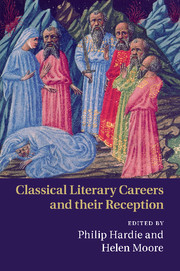Book contents
- Frontmatter
- Contents
- List of contributors
- Preface
- Note on the text
- Introduction: Literary careers – Classical models and their receptions
- 1 Some Virgilian unities
- 2 There and back again: Horace's poetic career
- 3 The Ovidian career model: Ovid, Gallus, Apuleius, Boccaccio
- 4 An elegist's career: from Cynthia to Cornelia
- 5 Persona and satiric career in Juvenal
- 6 The indistinct literary careers of Cicero and Pliny the Younger
- 7 Re-inventing Virgil's Wheel: the poet and his work from Dante to Petrarch
- 8 Did Shakespeare have a literary career?
- 9 New spins on old rotas: Virgil, Ovid, Milton
- 10 Bookburning and the poetic deathbed: the legacy of Virgil
- 11 Literary afterlives: metempsychosis from Ennius to Jorge Luis Borges
- 12 ‘Mirrored doubles’: Andrew Marvell, the remaking of poetry and the poet's career
- 13 Dryden and the complete career
- 14 Goethe's elegiac sabbatical
- 15 Wordsworth's career prospects: ‘peculiar language’ and public epigraphs
- Epilogue: Inventing a life – a personal view of literary careers
- List of works cited
- Index
9 - New spins on old rotas: Virgil, Ovid, Milton
Published online by Cambridge University Press: 10 November 2010
- Frontmatter
- Contents
- List of contributors
- Preface
- Note on the text
- Introduction: Literary careers – Classical models and their receptions
- 1 Some Virgilian unities
- 2 There and back again: Horace's poetic career
- 3 The Ovidian career model: Ovid, Gallus, Apuleius, Boccaccio
- 4 An elegist's career: from Cynthia to Cornelia
- 5 Persona and satiric career in Juvenal
- 6 The indistinct literary careers of Cicero and Pliny the Younger
- 7 Re-inventing Virgil's Wheel: the poet and his work from Dante to Petrarch
- 8 Did Shakespeare have a literary career?
- 9 New spins on old rotas: Virgil, Ovid, Milton
- 10 Bookburning and the poetic deathbed: the legacy of Virgil
- 11 Literary afterlives: metempsychosis from Ennius to Jorge Luis Borges
- 12 ‘Mirrored doubles’: Andrew Marvell, the remaking of poetry and the poet's career
- 13 Dryden and the complete career
- 14 Goethe's elegiac sabbatical
- 15 Wordsworth's career prospects: ‘peculiar language’ and public epigraphs
- Epilogue: Inventing a life – a personal view of literary careers
- List of works cited
- Index
Summary
As other essays in this volume have already indicated, the contours of the Virgilian rota, once considered the dominant career pattern for any serious Renaissance poet, do not seem as clear as they once did. Despite the trope of the wheel, critics have often focused on the linear, teleological thrust of the Virgilian model, which has been seen to give a progressive, developmental shape to the poet's life that reflected simultaneously the movement of civilization. As Michael Putnam's essay reminds us, Virgil's model is also a rota in a truer sense, as it comes full circle to trace a movement back to its earlier origins. Virgil's career ends where it began, in the dubious land of shades, umbrae. This return to origins reveals the unity of the works as a whole and brings them to a close in a final self-gathering of climactic fulfilment and resolution. But it also creates a counter, centrifugal pressure to the linear thrust of Virgil's career that resists closure. The unresolved tension between the two movements mirrors the conflict now frequently noted in the Aeneid itself. While Aeneas' career involves progression, his transformation from defeated Trojan into the Roman whose climactic victory over Turnus suggests the triumph of civilization over barbarism, the final moments of the text seem to suggest that the hero is relapsing into barbarism. The abrupt ending of the poem – which focuses on the slaying of the defeated Turnus – calls the progress of Rome into question.
- Type
- Chapter
- Information
- Classical Literary Careers and their Reception , pp. 179 - 196Publisher: Cambridge University PressPrint publication year: 2010
- 1
- Cited by



